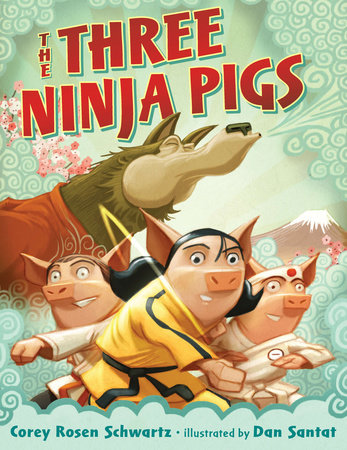Schwartz, Corey Rosen. The Three Ninja Pigs. Illustrated by Dan Santat. New York: G. P. Putnam’s Sons, 2012. ISBN 978-0-399-25514-4
Plot
“Once upon a dangerous time,” a bully of a wolf is blowing down the houses of other creatures around town. Three pigs decide to stop him—by enrolling in ninja school and learning martial arts. The first pig quickly dropped out of the school, and the second pig stopped not long after, but the third pig completed her training. When the wolf came around to the first pig’s house, the first pig realized his skills weren’t enough, so he ran to his brother’s house. His brother, the second pig, was also unable to stop the wolf, so they ran to their sister’s house. Their sister, the third pig, was able to stop the wolf and inspire her brothers to finish their martial arts training.
Analysis
This fractured fairy tale is a fun retelling of the three little pigs. The tale is set in Japan, as evidenced by illustrations of Mt. Fuji and elements of Japanese art and architecture. However, it is important to note that this is not a Japanese version of the tale, but that it is inspired by Japanese martial arts. The plot maintains the general format and theme of the traditional tale, but with a twist. Rather than wisdom, diligence, and hard work represented by materials and time spent building a house, these traits are represented by the time spent training in each pigs’ chosen martial arts. A nod to the traditional telling is seen in the artwork—the first pig lives in a house of straw, the second in a house of bamboo, and the third in a modern brick house. The fun, bright illustrations also incorporate elements of a comic book. Action scenes are divided into panels and some text is captured in speech bubbles. The text has a strong rhyme scheme and rhythm throughout. Though certain memorable phrases are used (such as “huff and puff” and “by the hair of my chinny-chin-chin”), they are not repeated throughout.
This retelling has additional themes based on modern values—the third pig, who saves the day due to her skill in karate, is a girl. She does not have to physically injure or kill the wolf to defeat him. Rather, she displays her skills to scare the wolf off. Her brothers realize the error of their ways and decide to finish their training, and then the siblings open their own dojo. This fresh version of a classic story will appeal to children of all ages with an interest in martial arts.
Awards and Recognitions
The Three Ninja Pigs has not received any awards, but it has received numerous positive reviews.
“A fractured fairy tale to outcharm the original, “The Three Ninja Pigs” manages to one-up the well-worn story by setting it in Japan, sprinkling it with the language and discipline of martial arts. All in hilarious, impeccable rhyme.”—The New York Times Book Review
“Anyone who knows the original story will be well aware of what comes next, but this standout version has so much motion, action, and laughs, kids will feel like they’re hearing it for the first time. […] Executed in Sumi brushwork on rice paper (and completed in Adobe Photoshop), the pictures have a three-dimensional feel that’s great when kicks and chops are being executed.”—Ilene Cooper, Booklist
“Schwartz’s sophomore outing is a standout among fractured fairy tales, masterfully combining rollicking limerick verse with a solid story, neither a slave to the other.”—Kirkus Reviews
Connections
This story would be enjoyable on its own, but children who are familiar with the “three pigs” story will get the most out of the parody. Consider reading a more traditional retelling of The Three Pigs, such as:
- The Three Little Pigs, retold and illustrated by Bernadette Watts
- The Three Little Pigs, retold and illustrated by Paul Galdone
- The Three Little Pigs, retold and illustrated by Margot Zemach
- The Three Little Pigs, retold and illustrated by Barry Moser
Also consider reading other creative versions and fractured tales, such as:
- Three Little Cajun Pigs, by Mike Artell and illustrated by Jim Harris
- The Three Little Wolves and the Big Bad Pig, by Eugene Trivizas and illustrated by Helen Oxenbury
- The Three Little Pigs and the Somewhat Bad Wolf, written and illustrated by Mark Teague
- The Three Little Javelinas, by Susan Lowell and illustrated by Jim Harris
- The True Story of the 3 Little Pigs, by Jon Scieszka and illustrated by Lane Smith
Children may enjoy telling, or writing and illustrating, their own version of the “three pigs” story. Schwartz’s version of the tale would also make a fun skit or dramatic reading, as in Readers Theater.
*This review was written for a youth literature class through Texas Woman’s University.

Hi Hilary, I love the language-arts idea of reading a variety of versions of The Three Little Pigs to inspire classroom students to write their own version. Thank you!
ReplyDelete